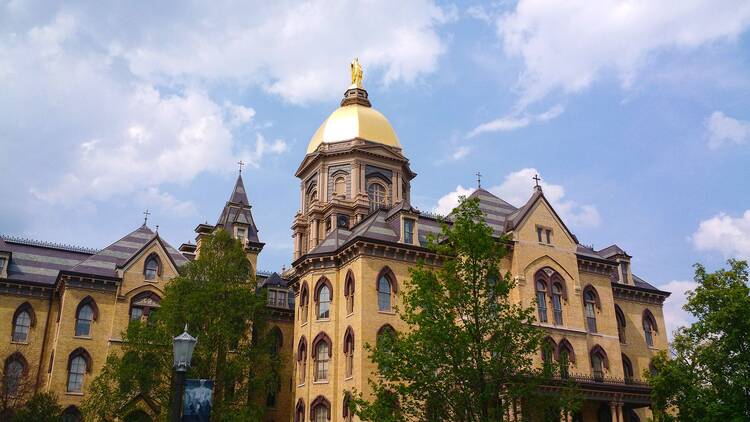Editor’s note, Aug. 18: Notre Dame announced on Tuesday evening that it had canceled in-person undergraduate classes for two weeks after a spike of coronavirus cases.
I walked onto the University of Notre Dame’s campus on Aug. 6, grateful that the school had decided to resume in-person classes after closing in the spring, at the start of the Covid-19 pandemic. Since I am an incoming international graduate student on an F-1 visa, a virtual semester would mean I would no longer have the legal status to remain in the United States. (Immigration and Customs Enforcement has reversed its July 6 ruling barring all international students from remaining in the United States should their programs remain virtual, but the prohibition on incoming international students taking virtual classes from within the country has remained in place.)
How long will this reopened campus last? And at what—or whose—cost?
While a saving grace for me, the campus reopening left the Notre Dame community to confront the new challenges of a socially distanced learning environment. After the first week of classes, two questions loomed in my mind: How long will this reopened campus last? And at what—or whose—cost?
Monday, Aug. 10
Eight confirmed Covid-19 cases on campus as of the first day of classes.
Four of my classes this semester are supposed to be held in person, with a fifth one on Zoom. Masks are required indoors at all times for faculty, staff and students (and outdoors whenever social distancing cannot be maintained). According to the university’s website, most classrooms allow for six feet of distance between all students.
In the basement classroom where my first in-person class of the semester takes place, large circular floor stickers show where each desk and chair ought to be. The walls are covered with posters of health tips, one reminding students to keep their masks on at all times and another reminding students to use the same seat each time they attend class—and register their seat number online, should the need for contact tracing arise.
In the basement classroom where my first in-person class of the semester takes place, large circular floor stickers show where each desk and chair ought to be.
This is a seminar of seven students, one of them on Zoom. The university is requiring “dual delivery” of courses, with in-person classes also available online for those with underlying health conditions and others who cannot attend physically (most commonly, international students who could not return to the United States due to border closing, or married students with young children).
We realize that since only the classroom’s desktop computer has a built-in microphone, the student joining via Zoom can only hear the professor, not other students’ voices. Noting this technical difficulty cannot be easily resolved, the professor suggests that we move the entire seminar online. But some students, wanting to keep direct interactions with their peers, ask to continue the in-person format for at least a few more weeks before re-evaluating.
Walking across the quad after class, I notice a group of twenty-odd students sitting elbow-to-elbow in a large circle on the lawn. Some have their masks on; the ones who are eating do not. A little too close, I think to myself, walking on the other side of the quad to maintain my distance.
Tuesday, Aug. 11
Thirteen confirmed Covid-19 cases on campus.
I attend my online class from my dining room. As someone with an autoimmune disorder that causes accelerated metabolism, I take the opportunity to drink water and eat throughout the three hour-long seminar, something I cannot do from behind a mask during an in-person class.
A friend tells me about an off-campus undergraduate student party that happened over the weekend, and another off-campus graduate student party that was shut down by the law school dean before it could take place.
Wednesday, Aug. 12
Twenty confirmed Covid-19 cases on campus.
My professor walks into class with a laptop, a tablet and a handful of cords to connect both devices to the classroom computer. She has converted her tablet into a digital whiteboard, projected to the classroom screen and screenshared for students joining via Zoom. Every time an in-person student makes a comment, the professor repeats it word for word for the remote students to hear.
Thursday, Aug. 13
Thirty confirmed Covid-19 cases on campus.
Inside the student center, clusters of unmasked students eat lunch together. Small tables that were placed six feet apart have been pushed together by students.
My ponytail brushes against the laptop of the student sitting behind me. Thankfully, everyone keeps their masks on the entire time.
My theology course meets in a small, tiered lecture hall. Seventeen students fill the seats. While the seats are six feet apart horizontally, the vertical distance between each student is less than a foot. My ponytail brushes against the laptop of the student sitting behind me. Thankfully, everyone keeps their masks on the entire time.
The professor appears tired. He says that he would rather teach this class online so that he could watch his children, whose grade school meets virtually this semester.
Friday, Aug. 14
Forty confirmed Covid-19 cases on campus.
As I walk out from my last class of the week, two members of the janitorial staff are rushing into the classroom to sanitize it. One of them tells me they sanitize the classrooms after every class.
Later I read an email from university officials telling students that the majority of confirmed Covid-19 cases are linked to two off-campus parties, each of them attended by more than 100 students. In the student-run newspaper The Observer, students have reported more large-group gatherings in which social distancing rules have not been observed.
As of this writing, Notre Dame has reported 147 confirmed Covid-19 cases from a total of 927 tests administered by University Health Services. The university’s reopening status depends on whether the spike in cases will continue. At a university that teaches the Catholic principle of promoting the common good, this semester may be the first time that many students are challenged to put this principle into practice. The question is, will we?
Editor’s note: For another view, from a faculty member at Notre Dame, see “Please don’t give up on in-person teaching, Notre Dame,” by Daniel Philpott, published on Aug. 27.










